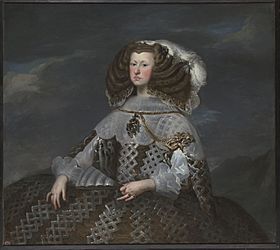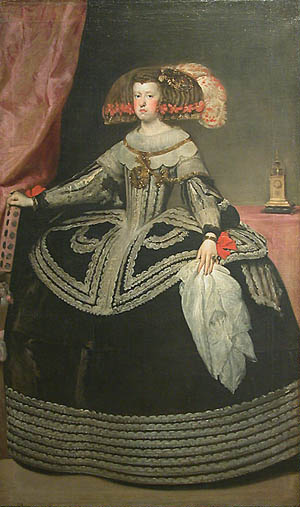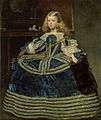Portrait of Mariana of Austria facts for kids
Quick facts for kids Portrait of Mariana of Austria |
|
|---|---|
 |
|
| Artist | Diego Velázquez |
| Year | 1652–1653 |
| Medium | Oil on canvas |
| Dimensions | 234.2 cm × 131.5 cm (92.2 in × 51.8 in) |
| Location | Museo del Prado, Madrid |
The Portrait of Mariana of Austria is a famous painting from 1652–1653. It was created by Diego Velázquez, a very important artist from Spain's "Golden Age." The painting shows Doña Mariana when she was 19 years old. She was the daughter of Emperor Ferdinand III.
Even though Mariana was known for being lively, Velázquez painted her with a serious look. She wears a black dress with lots of makeup. Her right hand rests on a chair, and she holds a lace handkerchief. Her dress is covered in jewelry, like a gold necklace and a large brooch. A clock behind her shows her high status.
Mariana was supposed to marry her cousin, Prince Baltasar Carlos. But he died when he was 16. So, in 1649, she married her uncle, Philip IV. This marriage helped keep the Habsburg family powerful. She became the queen consort (the king's wife). After Philip died in 1665, she ruled Spain for her young son, Charles II. She was a powerful ruler until she died in 1696.
Velázquez painted many portraits of the Spanish royal family in the 1650s. These paintings often show bright colors against dark backgrounds. They also feature fancy hairstyles and wide dresses. One of his most famous paintings, Las Meninas (1656), includes Mariana and her daughter, Infanta Margarita Teresa. There are three full-size versions of Mariana's portrait and some smaller ones. The painting in the Museo del Prado is the original.
Contents
Who Was Mariana of Austria?
Mariana was born on December 21, 1634, in Austria. Her parents were Ferdinand III, Holy Roman Emperor, and Maria Anna of Spain. Maria Anna was the sister of Philip IV of Spain. Mariana was one of only three of her parents' six children who lived to be an adult.
Philip IV's first wife died in 1644. Their only son, Balthasar Charles, died in 1646 from smallpox. He was only 13 and was supposed to marry Mariana. After his death, King Philip had no one to take over the throne.
A Royal Marriage
To keep the royal family strong, Philip asked Mariana, his niece, to marry him. Mariana was described as a "ruddy-cheeked, naive girl who loved a good laugh." But her royal duties were hard for her, especially the pressure to have a son.
Mariana and Philip had a daughter, the Infanta Margaret Theresa. They also had two sons. Felipe Próspero was supposed to be the next king, but he died at age three. Charles, who would become Charles II of Spain, was born later that year.
Mariana's life was not easy. She and Philip did not know each other before they married. He was over 40, and she was 19. She had many difficult pregnancies and miscarriages. When Philip died in 1665, she became the ruler for her son Charles. Charles was often sick and had disabilities. Mariana was able to lead Spain's government until she died in 1696.
What Does the Painting Show?
Velázquez wanted to make royal portraits more lively. This painting follows the rules for official royal portraits. It shows Mariana's importance. Her fancy clothes and jewelry are clear. Some people today think she looked quite ordinary and was unhappy in her marriage.
The painting uses colors like white, black, and red. A red velvet curtain makes the painting look like a stage. The curtain's color and fabric are like the table behind her. On the table is a gold clock shaped like a tower. The chair and table show her royal status. The clock reminds us of her duties as Queen and suggests she was a wise person.
Velázquez seems to show Mariana's true feelings. She looks elegant and wears very fashionable clothes. But she has a sulky expression. Some believe Mariana felt trapped by court life. She might have been bored, lonely, or homesick. These feelings might have changed her from a lively girl into a stubborn queen. Her serious look appears in other portraits too.
Details of Her Outfit

Mariana stands in a very stiff way. Her upper body seems almost hidden by her black dress. The dress is held up by a wide, stiff frame called a farthingale. Its width is highlighted by a wide lace collar and patterns on its edges. Her skin is very pale and has a lot of red makeup. This makes her face look almost like a doll's under her wig and large head-dress.
Mariana holds a lace handkerchief in her left hand. Her dress shows her interest in high fashion. It has silver braids and red ribbons. She wears many pieces of jewelry, including bracelets, gold chains, and a fancy gold brooch on her chest. Her brown hair has red ribbons and braids that spread out widely on each side. She also wears a large red and white feather plume that frames her face.
Why Was the Painting Made?
Velázquez was the official painter for the Spanish king. He was also in charge of palace lodging since 1652. He worked under a lot of pressure. He said his official duties left him little time to paint. He made fewer than 20 paintings in the last eight and a half years of his life. About 14 of these still exist, mostly of the royal family. He started painting these portraits after Philip and Mariana married in 1649.
When Ferdinand III, Mariana's father, asked for a portrait of his daughter, Philip asked Velázquez to return to Madrid. The Prado Museum says the painting was made between 1652 and 1653. Other experts agree. A copy of the painting was sent to Ferdinand on December 15, 1652. This means the original painting was finished before that date.
Velázquez painted Mariana again after Philip died in 1665. These later paintings show her sadness as a widow. Even though these portraits look serious, Mariana was known to be friendly and fun in real life. Another painting from 1653, Portrait of the Infanta Maria Theresa of Spain, shows a very similar pose. It also features a large wig, wide dress, and velvet curtain.
Copies of the Painting
The painting was listed in a record from 1700. At that time, it was displayed with a portrait of Philip IV. Velázquez's portrait of Philip was not finished. Some parts, like a lion, were only sketched. Before 1700, someone else added a piece of canvas to the top of Mariana's portrait. This was done to make it the same size as Philip's portrait.
Later in his life, Velázquez was very busy with his court duties. He would often paint only the upper body of a person from real life. Then, his helpers would finish the rest of the painting. Several full-size copies of Mariana's portrait exist. One is in the Kunsthistorisches Museum in Vienna. Another was sent to Archduke Leopold William in 1653, but it is now lost. A third copy was in the Prado Museum until the Musée du Louvre bought it in 1941. A smaller copy, made by his helpers, is in the Metropolitan Museum of Art.
Images for kids
-
Infanta Margarita Teresa in a Blue Dress, 1659. Kunsthistorisches Museum, Vienna. A later variant of Mariana's portrait.
-
Portrait of the Infanta Maria Theresa of Spain, 1653. Kunsthistorisches Museum, Vienna. Note the very similar hair, pose, dress and handkerchief.
-
Juan Bautista Martínez del Mazo, Mariana of Spain in Mourning, 1666, National Gallery, London
-
Velázquez, Detail from Las Meninas (1656) showing Mariana's daughter, the Infanta Margaret Theresa. Prado, Madrid.
-
Velázquez, Portrait of Philip IV, 1644. Frick Collection, New York.
-
Portrait of Prince Philip Prospero, 1659. Kunsthistorisches Museum, Vienna.
See also
 In Spanish: La reina Mariana de Austria para niños
In Spanish: La reina Mariana de Austria para niños
- List of works by Diego Velázquez










